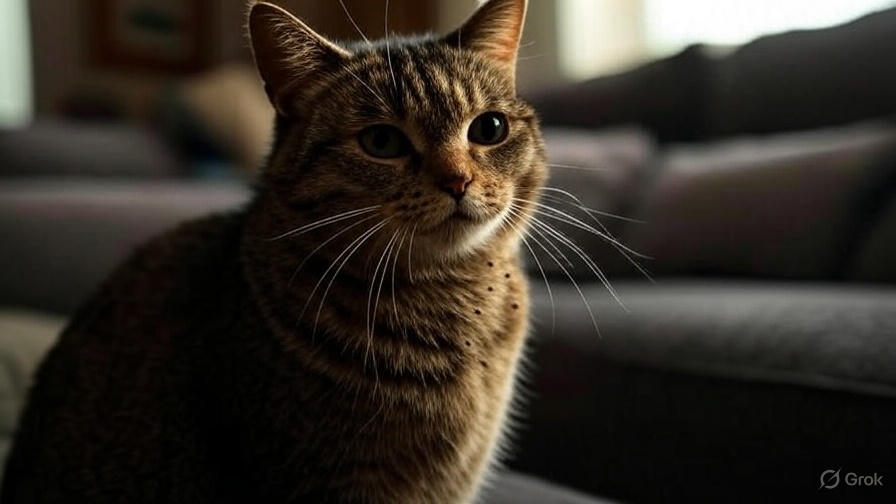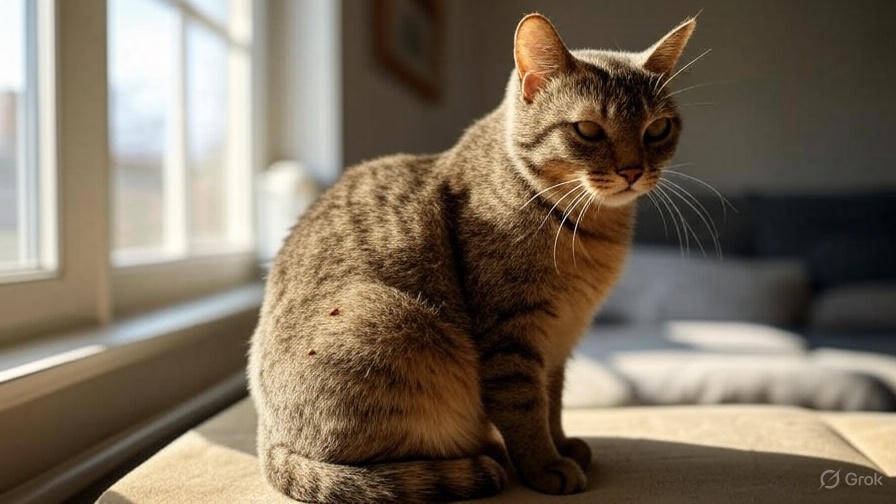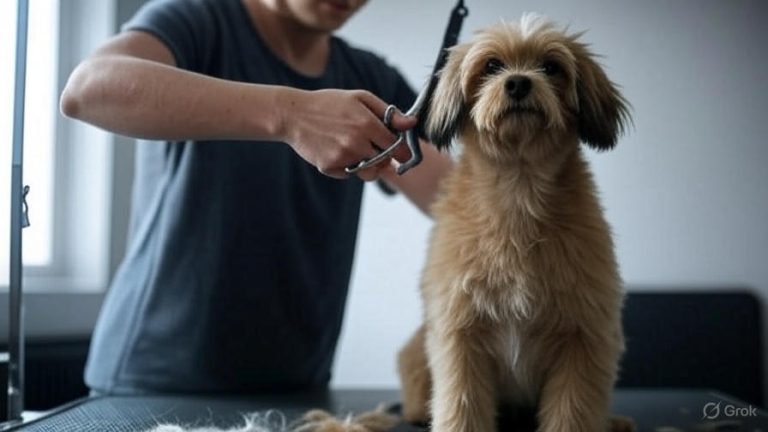How Can an Indoor Cat Get Fleas?
You keep your cat safely indoors, away from outdoor dangers and wild animals. You provide fresh food, clean water, and a warm bed. Yet somehow, you discover tiny black specks in your cat’s fur and notice them scratching constantly. The shocking reality hits you: your indoor cat has fleas.
This scenario confuses many cat owners who assume indoor cats remain completely safe from parasites. The truth reveals a different story. Indoor cats can indeed get fleas through various surprising pathways that most pet owners never consider.
The Reality of Indoor Cat Flea Infestations
Fleas represent one of the most persistent pet parasites worldwide. These tiny insects possess remarkable jumping abilities and survival instincts that allow them to infiltrate even the most protected indoor environments. Your indoor cat faces flea exposure through multiple routes that might surprise you.
The common misconception suggests that only outdoor cats deal with flea problems. However, veterinarians regularly treat indoor cats for flea infestations. Studies show that approximately 30% of indoor cats encounter flea problems at some point in their lives.
These parasites don’t discriminate between indoor and outdoor environments. They actively seek warm-blooded hosts and will exploit any opportunity to establish themselves in your home. Once fleas enter your living space, they can multiply rapidly and create a persistent infestation that affects your entire household.
Primary Ways Indoor Cats Contract Fleas
Human Transportation
You unknowingly serve as a flea taxi service for your indoor cat. Every time you step outside, you risk carrying flea eggs, larvae, or adult fleas on your clothing, shoes, or bags. These hitchhiking parasites can easily transfer from your belongings to your cat’s environment.
Your shoes present the highest risk factor for flea transportation. Flea eggs and larvae thrive in grass, soil, and carpeted areas where other animals have been present. When you walk through these areas, microscopic flea life stages attach to your shoe soles and get carried directly into your home.
Clothing also provides an excellent transport mechanism for fleas. If you visit friends with pets, walk through parks, or spend time in any area where animals frequent, fleas can jump onto your pants, socks, or jacket. Once inside your home, these fleas quickly locate your cat and begin feeding.

Other Household Pets
Dogs that go outside regularly can bring fleas into your home environment. Even if your dog receives flea treatments, occasional fleas may still attach to their fur during walks or outdoor playtime. These fleas can then transfer to your indoor cat through direct contact or by dropping off in shared living spaces.
The flea life cycle complicates this situation further. Adult fleas represent only about 5% of the total flea population in any environment. The remaining 95% consists of eggs, larvae, and pupae that develop in carpets, upholstery, and pet bedding. Your dog might introduce these life stages without you noticing any adult fleas.
Cross-contamination occurs easily in multi-pet households. Fleas don’t show loyalty to specific animals and will happily jump from one host to another. If your dog brings fleas inside, your indoor cat becomes an immediate target for these hungry parasites.
Previous Infestations
Flea eggs and larvae can remain dormant in your home for months before hatching. If your current indoor cat replaced a previous pet that had fleas, or if you moved into a home where the previous occupants had pets, dormant flea populations might still exist in your environment.
These resilient parasites can survive in carpet fibers, floorboard cracks, and upholstery for extended periods. Temperature changes, vibrations, and carbon dioxide levels can trigger dormant fleas to emerge and seek new hosts. Your indoor cat might encounter fleas that have been waiting patiently for the right conditions to activate.
Professional pest control treatments don’t always eliminate every flea egg or larva. Some hardy specimens survive in protected locations and eventually mature into adult fleas. This delayed emergence explains why some indoor cats develop flea problems weeks or months after moving to a new home.
Visitors and Service Personnel
Friends, family members, and service workers can inadvertently introduce fleas to your home. Anyone who owns pets or spends time around animals might carry flea eggs or larvae on their clothing or belongings. These unwitting transporters can deposit fleas throughout your home during their visit.
Delivery personnel, repair technicians, and cleaning services represent potential flea carriers. Their job requirements expose them to multiple homes and environments where fleas might be present. Each location they visit increases the chance of picking up and transferring flea life stages.
House guests who bring luggage or personal items from flea-infested environments can also introduce these parasites. Fleas readily attach to fabric surfaces and can survive for several days without feeding. Your indoor cat might encounter these transported fleas long after the visitors have departed.
Environmental Factors That Attract Fleas
Humidity and Temperature
Fleas thrive in warm, humid conditions that many homes provide year-round. Central heating systems create ideal environments for flea development, especially during winter months when humidity levels remain consistent. Your comfortable indoor climate also happens to be perfect for flea reproduction.
Carpeted areas retain moisture and provide excellent breeding grounds for flea larvae. These immature fleas feed on organic debris, pet dander, and adult flea feces found deep within carpet fibers. The combination of warmth, humidity, and food sources creates optimal conditions for rapid flea population growth.
Basements, crawl spaces, and areas with poor ventilation often harbor flea populations. These locations maintain consistent temperature and humidity levels that support flea development. Your indoor cat might encounter fleas that have been developing in these hidden areas for weeks or months.
Organic Matter and Debris
Flea larvae require organic material for nutrition during their development phase. Pet hair, skin flakes, food particles, and general household debris provide essential nutrients for growing fleas. Areas where these materials accumulate become prime flea breeding locations.
Upholstered furniture, especially pieces that your cat frequently uses, can harbor significant flea populations. The combination of pet hair, skin cells, and fabric fibers creates an ideal nursery for developing fleas. Your indoor cat might pick up fleas simply by sleeping on their favorite chair or sofa.
Vacuum cleaner bags and canisters sometimes contain viable flea eggs and larvae. If you don’t empty or replace these containers regularly, fleas can continue developing inside your vacuum cleaner. This situation creates an ongoing source of flea contamination that can reinfest your home and affect your indoor cat.
The Flea Life Cycle and Indoor Survival
Adult fleas represent only the tip of the iceberg in any flea infestation. The complete flea life cycle includes four distinct stages: egg, larva, pupa, and adult. This complex development process allows fleas to establish persistent populations in indoor environments.
Female fleas lay up to 50 eggs daily after feeding on your cat’s blood. These eggs don’t stick to your cat’s fur but instead fall off onto carpets, furniture, and bedding. The smooth, oval-shaped eggs develop into larvae within 2-14 days, depending on environmental conditions.
Flea larvae avoid light and burrow deep into carpet fibers, cracks, and crevices. They feed on organic debris for 5-11 days before spinning cocoons and entering the pupal stage. This transformation phase can last anywhere from 5 days to several months, depending on temperature and humidity levels.
The pupal stage represents the most resilient phase of flea development. Cocoons protect developing fleas from environmental threats and allow them to wait for optimal conditions before emerging. Vibrations, heat, and carbon dioxide levels trigger adult fleas to leave their cocoons and seek hosts.
Signs Your Indoor Cat Has Fleas
Physical Symptoms
Excessive scratching represents the most obvious sign of flea infestation. Your cat will scratch more frequently and intensely than normal, often focusing on specific areas like the base of the tail, neck, and behind the ears. This increased scratching behavior indicates flea activity and irritation.
Flea bite dermatitis causes red, inflamed skin that may develop into open sores from constant scratching. Some cats develop allergic reactions to flea saliva, resulting in more severe skin irritation and hair loss. These symptoms require immediate attention to prevent secondary bacterial infections.
Small, dark specks in your cat’s fur indicate flea dirt, which consists of digested blood excreted by adult fleas. If you place these specks on a damp paper towel, they will turn reddish-brown, confirming the presence of blood and fleas. This test provides definitive proof of flea infestation.
Behavioral Changes
Cats with fleas often become more restless and agitated than usual. They may pace, vocalize more frequently, or seem unable to settle comfortably. The constant irritation from flea bites affects their normal behavior patterns and sleep cycles.
Excessive grooming represents another common response to flea infestation. Your cat might lick and bite at their fur more intensely, sometimes creating bald patches or skin wounds. This behavior indicates significant discomfort and the need for immediate flea treatment.
Some cats become less social and hide more frequently when dealing with flea problems. The stress and discomfort from constant itching can affect their personality and interaction with family members. They might avoid their usual favorite spots or refuse to be petted in certain areas.
Prevention Strategies for Indoor Cats
Regular Grooming and Inspection
Daily brushing helps you detect flea problems early and removes some adult fleas before they can establish breeding populations. Use a fine-toothed flea comb to check for live fleas and flea dirt, especially around your cat’s neck, tail base, and hindquarters.
Regular inspection of your cat’s skin and fur allows you to identify potential problems before they become serious infestations. Look for signs of excessive scratching, red or irritated skin, and unusual amounts of hair loss. Early detection makes treatment more effective and less stressful for your cat.
Bathing your indoor cat occasionally with mild shampoo can help remove fleas and flea dirt. While cats generally don’t require frequent baths, occasional washing during flea season or after potential exposure can provide additional protection. Use lukewarm water and gentle, cat-safe products.
Environmental Management
Vacuum your home frequently, paying special attention to areas where your cat spends time. Focus on carpets, upholstery, pet bedding, and cracks between floorboards. Dispose of vacuum bags immediately or empty bagless canisters into sealed trash containers to prevent flea re-emergence.
Wash your cat’s bedding, blankets, and any removable fabric items in hot water weekly. High temperatures kill all stages of flea development and help eliminate established populations. Dry these items on high heat settings when possible for maximum effectiveness.
Control humidity levels in your home to create less favorable conditions for flea development. Use dehumidifiers in damp areas and ensure proper ventilation throughout your living space. Fleas struggle to survive in environments with humidity levels below 50%.
Preventive Treatments
Consult your veterinarian about appropriate flea prevention products for your indoor cat. Many effective options exist, including topical treatments, oral medications, and flea collars designed specifically for indoor use. These products provide ongoing protection against flea infestations.
Year-round prevention often proves more effective and economical than treating established infestations. Modern flea prevention products kill adult fleas quickly and disrupt the reproductive cycle, preventing population growth. Your veterinarian can recommend the best options based on your cat’s specific needs.
Regular veterinary checkups allow professional assessment of your cat’s flea risk and overall health. Your veterinarian can detect early signs of flea problems and adjust prevention strategies based on seasonal changes and local flea activity levels.
Treatment Options for Flea-Infested Indoor Cats
Veterinary Treatments
Professional flea treatments provide the most effective solution for established infestations. Your veterinarian can prescribe prescription-strength products that kill adult fleas within hours and prevent new fleas from developing. These treatments offer superior results compared to over-the-counter alternatives.
Topical spot-on treatments applied between your cat’s shoulder blades provide month-long protection against fleas. These products contain active ingredients that spread through your cat’s skin and hair follicles, creating a protective barrier against flea attachment and feeding.
Oral flea medications offer an alternative for cats who resist topical treatments. These products work systemically to kill fleas that bite your cat and can provide rapid relief from active infestations. Some oral treatments also prevent flea eggs from hatching, breaking the reproductive cycle.
Home Environment Treatment
Treating your home environment simultaneously with your cat ensures complete flea elimination. Adult fleas living on your cat represent only a small portion of the total flea population. The majority of fleas exist as eggs, larvae, and pupae throughout your home environment.
Professional pest control services can provide comprehensive home treatment for severe infestations. These specialists use specialized equipment and products to treat carpets, upholstery, and other areas where fleas develop. Professional treatment often provides faster and more thorough results than DIY approaches.
Flea sprays designed for home use can supplement professional treatments or address mild infestations. Focus on areas where your cat spends time, including carpets, furniture, and bedding. Follow product instructions carefully and ensure adequate ventilation during application.
Natural and Alternative Approaches
Diatomaceous earth (food-grade only) can help control flea populations when applied to carpets and pet areas. This natural product damages flea exoskeletons and causes dehydration. However, use caution around pets and humans, as the powder can irritate respiratory systems.
Essential oils like lavender, eucalyptus, and peppermint may repel fleas when used properly. Create diluted solutions for carpet treatment or use in diffusers to create less attractive environments for fleas. Always research pet-safe concentrations and avoid direct application to your cat.
Regular vacuuming combined with immediate disposal of vacuum contents can significantly reduce flea populations. The mechanical action of vacuuming removes eggs, larvae, and some adult fleas from carpets and upholstery. Empty vacuum containers immediately to prevent flea re-emergence.
The Importance of Consistent Prevention
Maintaining year-round flea prevention for your indoor cat provides the best protection against infestations. Even cats that never venture outside face ongoing risk from the various pathways through which fleas can enter your home. Consistent prevention eliminates the stress and expense of treating active infestations.
Modern flea prevention products offer excellent safety profiles and effectiveness when used as directed. The small monthly cost of prevention far outweighs the expense and difficulty of treating established flea problems. Your cat will be more comfortable, and your home will remain flea-free.
Remember that flea prevention protects not only your cat but also your family and home environment. Fleas can bite humans and cause allergic reactions in sensitive individuals. Some fleas also carry diseases that can affect both pets and people, making prevention a health priority for your entire household.
Your indoor cat depends on you for protection against parasites and diseases. By implementing comprehensive flea prevention strategies, you ensure their continued health and comfort while maintaining a pest-free home environment. The investment in prevention pays dividends in your cat’s well-being and your peace of mind.







